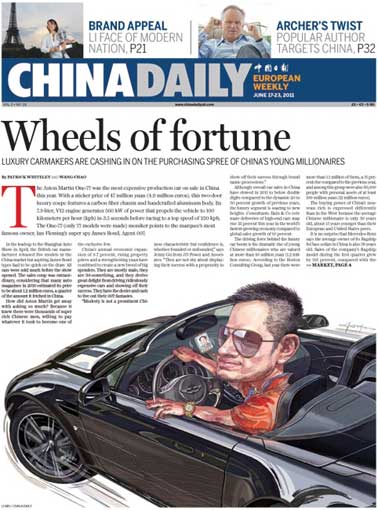Global advancement must start at home
Updated: 2011-06-17 11:14
By Shujie Yao (China Daily European Weekly)
|
 |
China officially overtook Japan to become the world's second-largest economy earlier this year, but the efficacy of its efforts to create compelling business cases for Chinese multinationals in developed economies lags that of its eastern neighbor.
Its failure to emulate Japan and South Korea in producing world famous brands, such as Toyota and Samsung, highlights the fundamental weaknesses of its domestic economic structure that is continuing to dent its global competitiveness.
There is evidence, though, that China's "go-global" strategy is gathering momentum. According to the Asia Society, Chinese overseas direct investment could reach as high as $2 trillion (1.4 trillion euros) by 2020 and a senior government official has told China Daily that China's outbound investment will overtake its inbound foreign direct investment within three years. Yet international success will not equate to the sheer volume of money poured overseas.
Future economic growth in China is tied to the fate of its multinationals. If Chinese companies fail to make an impact in ultra-competitive Western markets, then it is highly unlikely that China will be able to sustain another 20 or 30 years of rapid growth.
China's leaders have long recognized the need to register commercial success abroad. Having officially implemented its "go-out policy" in 1999, their global strategy is clear: Let State-owned enterprises (SOEs) enjoy monopoly at home, allowing them to accrue abnormal profits, and subsidize them with generous bank credits so they can flex superior monetary muscle in front of foreign counterparts.
But the flaws in this nuance-free approach are deepening. Cash reserves alone are insufficient for Chinese firms to secure long-term, profitable footholds in developed markets overseas.
The uncomfortable truth for Chinese SOEs is their dearth of experience of genuine competition. Profits have been too easy to come, thanks to the monopolistic environment in which they operate at home. Last year the total combined profit of China's two most profitable SOEs was equivalent to that of the largest 500 private firms. In 2010, the total profits of just over 100 large SOEs were about 2 trillion yuan (215.2 billion euros) and only a tiny fraction of those profits was delivered to the State.
SOEs lack incentives to innovate and develop a technological expertise capable of rivaling that of Western business giants. Unlike South Korea and Japan, China has a seemingly limitless domestic market and firms can record impressive growth without crossing borders.
I have met the chairmen of two of China's largest private companies, both of whom were formerly among the country's top five richest men, according to the Hurun wealth list. Neither of them has ever had any plans to enter developed markets overseas, citing high risks, poor technology and products that often fail to meet minimum quality standards required by the European Union.
In addition, private firms in China lack State support, business scale and, crucially, access to bank credit. As a measure of the discrimination that still plagues the private sector in China, two-thirds of all bank loans are channeled to the public sector despite accounting for only 15 percent of employment.
They also struggle with human capital. Educated graduates are lured by the prestige and higher pay that working for government organizations and SOEs in China brings, and employment in the private sector is seen as the last resort. Salaries in the State sector are 1.8 times higher than private sector salaries and a government job offers attractive pension schemes and far greater job security.
China's march across the globe has instead centered on energy deals and mergers and acquisitions. It has enjoyed plenty of success in locking in a stable supply of natural resources, securing loans-for-oil deals and purchasing majority stakes in Western mining companies.
A significant part of this shopping spree has taken place across Latin America, a region that has traditionally been a United States stronghold. Chinese companies have secured long-term oil supplies from Brazil and Venezuela, and commodities such as soybeans and wheat from Argentina.
Mergers and acquisitions serve to accelerate China's push into Western markets but there are reservations over the sustainability of such a strategy. Acquisitions carry high price tags and China is not yet adept at managing the purchased assets.
Chinese carmaker Geely's takeover of Volvo is a case in point: It has given China little access to technology, as the innovation engineers are all non-Chinese. Aggressive maneuvers can also attract political opposition as State-owned mining company Chinalco found in its failed bid for Rio Tinto.
Furthermore, an acquisition strategy deflects attention from the need to develop strong Chinese brands known to Western consumers and restore credibility to a made-in-China label repeatedly knocked by safety scandals. Memories of contaminated pet food and toxic toothpaste still weigh heavy on the minds of global consumers.
Computer maker Lenovo is perhaps the Chinese company that is closest to establishing a truly global brand. Yet witness the headline that accompanied a recent profile of Lenovo senior vice-president Milko van Duijl published by the United Kingdom's Daily Telegraph: "Lenovo: the biggest computer maker most people have never heard of."
Lenovo is the fourth-largest computer maker in the world having built on its purchase of IBM's personal computer business six years ago, but it is significant that the majority of its senior executives are not Chinese nationals. According to the Daily Telegraph article, Lenovo will soon launch in Germany and already agreed to buy 37 percent of German computer company Medion AG.
The outcome of Lenovo's entry into the German market will give a strong indication of the company's future prospects in Western economies. Chinese automakers will also be watching closely as they continue to invest heavily in creating attractive domestic brands such as Chang'an and the BYD electricity-powered models, which they hope will make an impact in the US and Europe.
Meanwhile, China's leaders must translate the ambitious promises set out in the 12th Five-Year Plan (2011-2015) into action. Rapid economic expansion has been largely based on export processing and low-level manufacturing of consumer goods, capitalizing on abundant cheap labor and relying on technologies imitated or imported from the developed world.
To overhaul its economic structure, China plans to invest aggressively in science, technological innovation and education to boost the labor productivities of its industries. The government should start by establishing an incentive program to encourage greater domestic competition, allowing private enterprises to compete fairly with State-owned firms. Bank credit needs to be loosened for private companies and a tough regulatory regime should be set in place to guard against state monopoly.
China needs intelligent investment. Through its "Project 985" - a commitment to university research funding - the government has increased research investment by 20 percent every year for the past decade. But since universities are treated like government organizations and not autonomous institutions, the efficiency of this investment has been called into question.
Can China succeed in hauling itself up the technological ladder? It will be a painful and lengthy process. The country still has a large reservoir of cheap, rural labor, meaning the pressure for innovation and technology upgrading has not reached its peak.
Although labor costs have risen in recent years, an increasing number of low-tech manufacturing firms have been moving from the more expensive coastal and eastern regions to inland and western areas.
More rural workers, formerly economic migrants, are choosing to stay and work in their local cities for even lower levels of pay. In Guangdong, in particular, rural migrant workers have shown a growing reluctance to return to work each year after the annual Spring Festival.
A slowdown in inter-provincial migration reduces regional inequality and environmental damage to densely populated coastal cities. However, labor costs will eventually rise across all provinces, calling for acceleration in technological progress.
China's total GDP may well surpass that of the US by 2020, but its per capita GDP will still be less than one quarter of the US level. In other words, when China becomes the largest economy in the world, it will still be a developing country.
Its ambition to grow into a rich and powerful nation will require Chinese multinationals to flourish overseas. Without its own respected brands, China will always languish at the lower end of the value chain. China's future will ultimately depend on its ability to create, not replicate.
The author is professor of economics and head of the School of Contemporary Chinese Studies at the University of Nottingham, which also houses the China Policy Institute.
E-paper

Pearl on the Yangtze
Wuxi is considered a town of natural beauty and its motto is "city of water and warmth".
Prose and consternation
Riding on a mystery train
Way of a warrior
Specials

When two are one
After a separation of 360 years, Huang Gongwang's famous Dwelling in the Fuchun Mountains has been made whole again.

Wealth of difference
Rich coastal areas offer contrasting ways of dealing with country's development

Seal of approval
The dying tradition of seal engraving has now become a UNIVERSITY major
